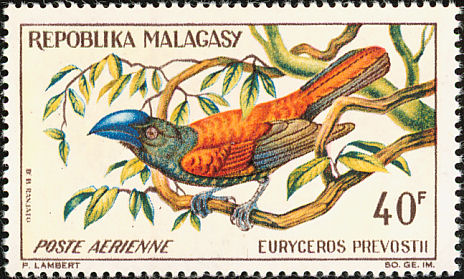|
Helmet Vanga (Euryceros prevostii) - Wiki
| 제목: | Helmet Vanga (Euryceros prevostii) - Wiki
| |

| 해상도: 464x279
파일크기: 60470 Bytes
등록시간: 2007:12:07 18:53:43
|
Helmet Vanga
From Wikipedia, the free encyclopedia
Order: Passeriformes
Family: Vangidae
[Photo] Helmet Vanga Euryceros prevostii. Source: Bird stamps from Malagasy, 1963. URL: www.birdtheme.org/country/malagasy.html
The Helmet Vanga Euryceros prevostii is a distinctive-looking bird of the vanga family, Vangidae, with a huge arched blue bill. It is the only member of its genus.
It is restricted to lowland and lower montane rainforests in north-east Madagascar.
Sites where it can be found include Marojejy Strict Nature Reserve, the Masoala National Park and Mantadia National Park.
Adults mainly eat large insects, but food items brought to young in the nest may be more varied , including snails, lizards, spiders and crabs.
The binomial of this bird commemorates the French artist Florent Pr??vost.
http://en.wikipedia.org/wiki/Helmet_Vanga
| The text in this page is based on the copyrighted Wikipedia article shown in above URL. It is used under the GNU Free Documentation License. You may redistribute it, verbatim or modified, providing that you comply with the terms of the GFDL. |
|
^o^
동물그림창고 똑똑전화 누리집
^o^
|
|